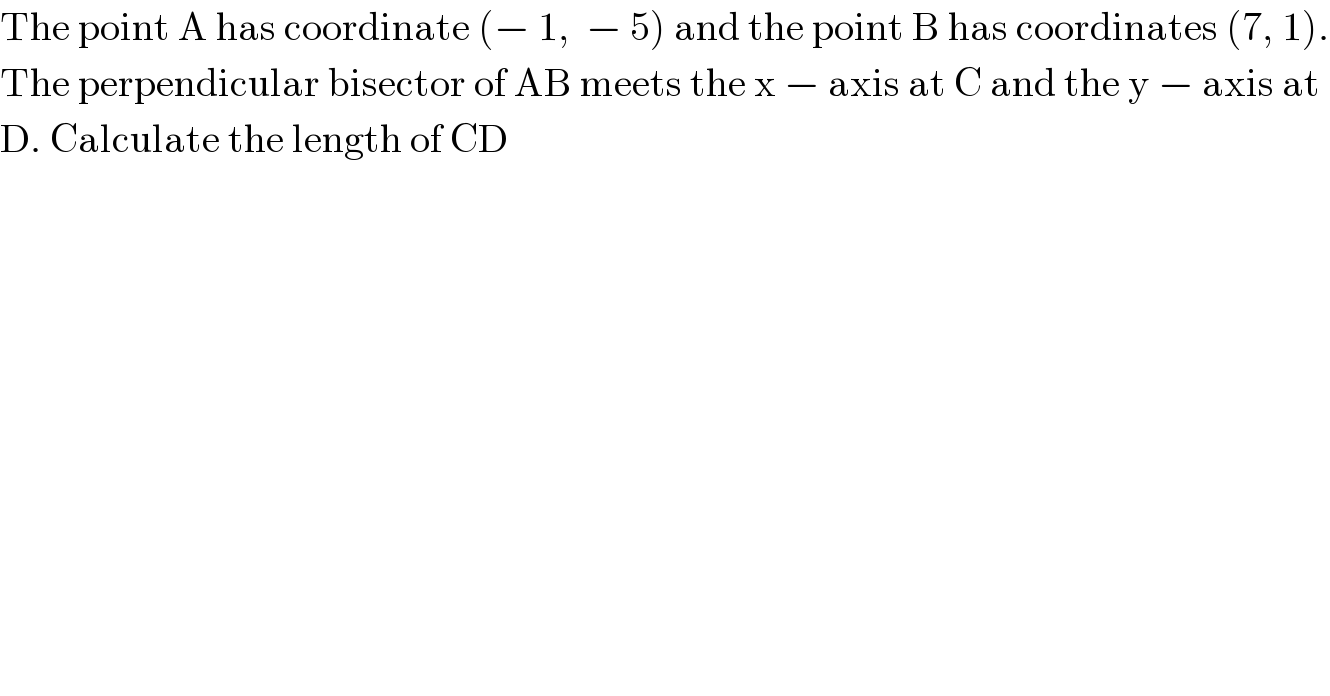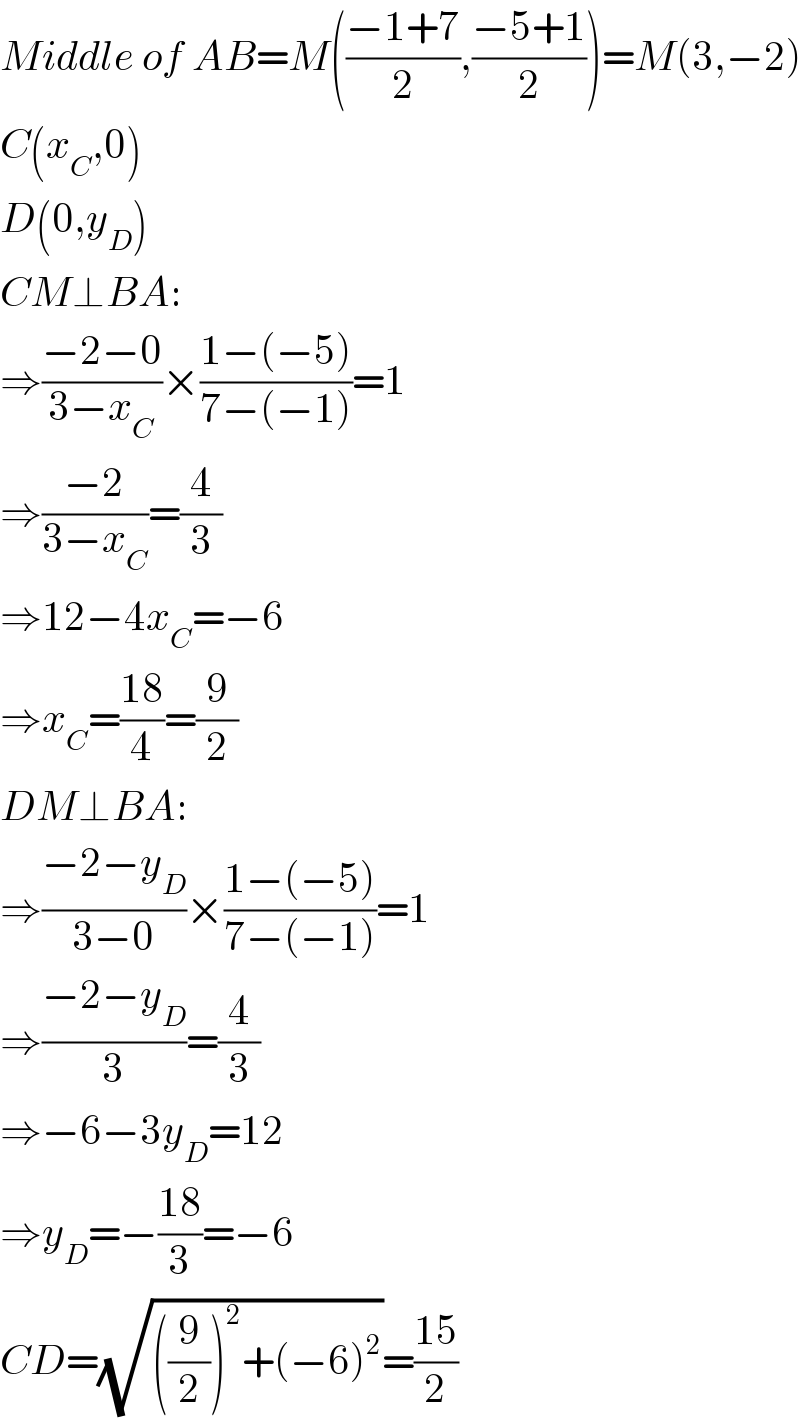Question Number 25200 by tawa tawa last updated on 06/Dec/17

$$\mathrm{The}\:\mathrm{point}\:\mathrm{A}\:\mathrm{has}\:\mathrm{coordinate}\:\left(−\:\mathrm{1},\:\:−\:\mathrm{5}\right)\:\mathrm{and}\:\mathrm{the}\:\mathrm{point}\:\mathrm{B}\:\mathrm{has}\:\mathrm{coordinates}\:\left(\mathrm{7},\:\mathrm{1}\right). \\ $$$$\mathrm{The}\:\mathrm{perpendicular}\:\mathrm{bisector}\:\mathrm{of}\:\mathrm{AB}\:\mathrm{meets}\:\mathrm{the}\:\mathrm{x}\:−\:\mathrm{axis}\:\mathrm{at}\:\mathrm{C}\:\mathrm{and}\:\mathrm{the}\:\mathrm{y}\:−\:\mathrm{axis}\:\mathrm{at} \\ $$$$\mathrm{D}.\:\mathrm{Calculate}\:\mathrm{the}\:\mathrm{length}\:\mathrm{of}\:\mathrm{CD} \\ $$
Answered by mrW1 last updated on 06/Dec/17

$${Middle}\:{of}\:{AB}={M}\left(\frac{−\mathrm{1}+\mathrm{7}}{\mathrm{2}},\frac{−\mathrm{5}+\mathrm{1}}{\mathrm{2}}\right)={M}\left(\mathrm{3},−\mathrm{2}\right) \\ $$$${C}\left({x}_{{C}} ,\mathrm{0}\right) \\ $$$${D}\left(\mathrm{0},{y}_{{D}} \right) \\ $$$${CM}\bot{BA}: \\ $$$$\Rightarrow\frac{−\mathrm{2}−\mathrm{0}}{\mathrm{3}−{x}_{{C}} }×\frac{\mathrm{1}−\left(−\mathrm{5}\right)}{\mathrm{7}−\left(−\mathrm{1}\right)}=\mathrm{1} \\ $$$$\Rightarrow\frac{−\mathrm{2}}{\mathrm{3}−{x}_{{C}} }=\frac{\mathrm{4}}{\mathrm{3}} \\ $$$$\Rightarrow\mathrm{12}−\mathrm{4}{x}_{{C}} =−\mathrm{6} \\ $$$$\Rightarrow{x}_{{C}} =\frac{\mathrm{18}}{\mathrm{4}}=\frac{\mathrm{9}}{\mathrm{2}} \\ $$$${DM}\bot{BA}: \\ $$$$\Rightarrow\frac{−\mathrm{2}−{y}_{{D}} }{\mathrm{3}−\mathrm{0}}×\frac{\mathrm{1}−\left(−\mathrm{5}\right)}{\mathrm{7}−\left(−\mathrm{1}\right)}=\mathrm{1} \\ $$$$\Rightarrow\frac{−\mathrm{2}−{y}_{{D}} }{\mathrm{3}}=\frac{\mathrm{4}}{\mathrm{3}} \\ $$$$\Rightarrow−\mathrm{6}−\mathrm{3}{y}_{{D}} =\mathrm{12} \\ $$$$\Rightarrow{y}_{{D}} =−\frac{\mathrm{18}}{\mathrm{3}}=−\mathrm{6} \\ $$$${CD}=\sqrt{\left(\frac{\mathrm{9}}{\mathrm{2}}\right)^{\mathrm{2}} +\left(−\mathrm{6}\right)^{\mathrm{2}} }=\frac{\mathrm{15}}{\mathrm{2}} \\ $$
Commented by tawa tawa last updated on 06/Dec/17

$$\mathrm{Wow},\:\mathrm{God}\:\mathrm{bless}\:\mathrm{you}\:\mathrm{sir}. \\ $$
Commented by tawa tawa last updated on 06/Dec/17

$$\mathrm{please}\:\mathrm{sir},\:\mathrm{help}\:\mathrm{me}\:\mathrm{with}\:\mathrm{the}\:\mathrm{other}\:\mathrm{ones}. \\ $$
